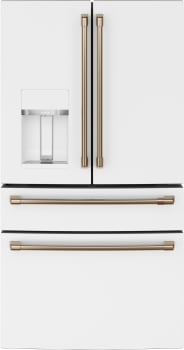Samsung 22.0 cu. ft. Side by Side Refrigerator in Fingerprint Resistant Stainless Steel, Counter Depth
Counter Depth, Built-In look blends in perfectly with cabinetry. Fingerprint Resistant Finish withstands everyday smudging. Multi-air vents keep every item on every shelf evenly cooled.
The Samsung 22 cu. ft. Side by Side Counter Depth refrigerator is beautifully designed with a built in look for a seamless fit. It offers smooth and streamlined exterior design features beautiful flat doors, a minimal display dispenser, and easy to open recessed handles that blend beautifully into your cabinetry, adding function and style to your kitchen.
- Modern built in look, that blends beautifully into your cabinetry
- Fingerprint Resistant Finish for less smudging which means less cleaning
- All Around Cooling to keep every item evenly cooled
- In-Door Ice Maker with high capacity and saves shelf space
- Minimal Display Dispenser provides easy access
- Wi-Fi and Bixby Enabled to control and monitor your refrigerator remotely
- LED lighting designed to beautifully light up the interior of your fridge
- Easily adjustable shelf to fit taller items
- Gallon Door Bins provides more shelf space inside the fridge
- 2 Clear Drawers to keep your fruits and vegetables organized
- ENERGY STAR® certified that’s eco-friendly and energy efficient
- Door Alarm alerts you if the doors are left open
- Accessibility (ADA Compliant) for easy to reach controls for everyone
Additional information
| Depth (Excluding Handles) | 28.59 |
|---|---|
| Depth (Including Handles) | 28.59 |
| Depth (Less Door) | 24.03 |
| Depth With Door Open 90 Degrees (In) | 46.41 |
| Height to Top of Door Hinge (in.) | 70.09 |
| Height to Top of Refrigerator (in.) | 68.68 |
| Product Depth x Height x Width (in.) | 28.625 x 70.0625 x 35.88 |
| Refrigerator Width (In.) | 35.91 |
| Certifications and Listings | ADA Compliant,Energy Star,UL Listed |
| Manufacturer Warranty | Five (5) years Parts and Labor on sealed Refrigeration system only* Ten (10) years Part and Five (5) years Labor on Digital Inverter Compressor (*Compressor, evaporator, condenser, drier, connecting tubing) |






by Chris
It is a very nice refrigerator and we are very happy with it. Shipping and delivery went great.
by Mike
It’s very quiet and beautiful!
by Jason
Most everything about the refrigerator is great including the space management inside, the cool little ice cubes, and the overall fit and finish…the only two issues we have is one, there isn’t an LED in the water/ice dispenser on the door…I am always filling my Yeti in the dark and it bugs me I have to put the light on to fill my water and ice. Second (this is my wife’s issue) the door handles are in the side of the doors. I happen to like this feature as door handles always seem to get loose and dirty on refrigerators but my wife doesn’t like the fact that you have to feel around the side of the door to find the slots to put your fingers in to open the doors.
by Larry
The appearance is great. No handles makes it very sleek and modern. The shelves don’t adjust but they are adequately spaced. The ice maker and water dispenser work well. Ice maker is a little noisy but no worse than other refrigerators I have owned. The counter depth feature is perfect for my small kitchen.
by Kathryn
The counter depth size is perfect for a galley kitchen.
by Jasmine
So far so good! Love the design. It’s quiet although I don’t have water line hooked up yet. (Need kitchen remodel this spring) Delivery was successful. Very happy with my Home Depot purchase!
by Arnold
Perfect fit for our existing space. Arrived as promised. We love the sleek design, no protruding handles. Very modern and eye appealing.